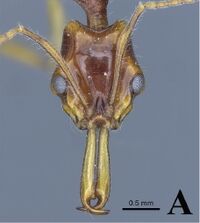Anochetus gracilis
| Anochetus gracilis | |
|---|---|

| |
| Scientific classification | |
| Kingdom: | Animalia |
| Phylum: | Arthropoda |
| Class: | Insecta |
| Order: | Hymenoptera |
| Family: | Formicidae |
| Subfamily: | Ponerinae |
| Tribe: | Ponerini |
| Genus: | Anochetus |
| Species: | A. gracilis |
| Binomial name | |
| Anochetus gracilis Karavaiev, 1925 | |
Nothing is known about the biology of Anochetus gracilis.
Identification
Chen et al. (2019) - China: Syntype worker images of Anochetus risii and Anochetus gracilis from AntWeb show the following differences: 1) inner margin of mandibles with no denticles in the worker of Anochetus gracilis, but possesses several distinct denticles in the worker of Anochetus risii; 2) the maximum diameter of eye is much larger than the maximum width of mandible in the worker of Anochetus gracilis, but smaller than or just equal to maximum width of mandible in the worker of Anochetus risii; 3) pronotal sides distinctly striate in the worker of Anochetus gracilis, but smooth and shining in the worker of Anochetus risii.
Distribution
Indonesia: Java.
Latitudinal Distribution Pattern
Latitudinal Range: -6.583330154° to -6.583330154°.
| North Temperate |
North Subtropical |
Tropical | South Subtropical |
South Temperate |
- Source: AntMaps
Distribution based on Regional Taxon Lists
Indo-Australian Region: Indonesia (type locality).
Distribution based on AntMaps
Distribution based on AntWeb specimens
Check data from AntWeb
Countries Occupied
| Number of countries occupied by this species based on AntWiki Regional Taxon Lists. In general, fewer countries occupied indicates a narrower range, while more countries indicates a more widespread species. |

|
Estimated Abundance
| Relative abundance based on number of AntMaps records per species (this species within the purple bar). Fewer records (to the left) indicates a less abundant/encountered species while more records (to the right) indicates more abundant/encountered species. |

|
Biology
|
Castes
Nomenclature
The following information is derived from Barry Bolton's Online Catalogue of the Ants of the World.
- gracilis. Anochetus gracilis Karavaiev, 1925c: 286, fig. 9 (w.q.) INDONESIA (Java).
- Type-material: syntype workers, syntype queens (numbers ot stated).
- [Notes (i): Baroni Urbani, 1973b: 143, cites 2w, 1q syntypes NHMB; (ii) Kostyuk, 1976: 93, cites 13w, 2q, 1m SIZK (the male not mentioned in the original description); (iii) Radchenko, Fisher, et al. 2023: 13, cite 26w, 9q syntypes SIZK (and exclude the male from the type-series).]
- Type-locality: Indonesia: Java, Buitenzorg (= Bogor), Botanical Gardens, 1912-13, Nr. 2416 (W. Karawaiew).
- Type-depositories: NHMB, SIZK.
- Junior synonym of risii: Brown, 1978c: 558; Bolton, 1995b: 64; Zhou, 2001b: 29.
- Status as species: Chapman & Capco, 1951: 39; Chen, Z., Yang & Zhou, 2019: 70.
- Distribution: Indonesia (Java).
Description
References
- Brown, W. L., Jr. 1978c. Contributions toward a reclassification of the Formicidae. Part VI. Ponerinae, tribe Ponerini, subtribe Odontomachiti. Section B. Genus Anochetus and bibliography. Studia Entomologica. 20:549-638. (page 558, junior synonym of risii)
- Chen, Z., Yang, Z., Zhou, S. 2019. Review of the ant genus Anochetus Mayr, 1861 (Hymenoptera, Formicidae) from China, with revival of the valid status of Anochetus gracilis. Journal of Hymenoptera Research 68: 49–74 (DOI 10.3897/jhr.68.30784).
- Karavaiev, V. 1925c. Ponerinen (Fam. Formicidae) aus dem Indo-Australischen Gebiet. (Schluss). Konowia 4: 276-296 (page 286, fig. 9 worker, queen described)
- Radchenko, A.G., Fisher, B.L., Esteves, F.A., Martynova, E.V., Bazhenova, T.N., Lasarenko, S.N. 2023. Ant type specimens (Hymenoptera, Formicidae) in the collection of Volodymyr Opanasovych Karawajew. Communication 1. Dorylinae, Poneromorpha and Pseudomyrmecinae. Zootaxa, 5244(1), 1–32 (doi:10.11646/zootaxa.5244.1.1).
References based on Global Ant Biodiversity Informatics
- CSIRO Collection
- Chapman, J. W., and Capco, S. R. 1951. Check list of the ants (Hymenoptera: Formicidae) of Asia. Monogr. Inst. Sci. Technol. Manila 1: 1-327
- Chen Z., Z. Yang, and S. Zhou. 2019. Review of the ant genus Anochetus Mayr, 1861 (Hymenoptera, Formicidae) from China, with revival of the valid status of Anochetus gracilis. Journal of Hymenoptera Research 68: 49–74.
- Karavaiev V. 1925. Ponerinen (Fam. Formicidae) aus dem Indo-Australischen Gebiet. (Schluss). Konowia 4: 276-296.
- Karavaiev V. 1926. Ameisen aus dem Indo-Australischen Gebiet. Treubia 8: 413-445.

